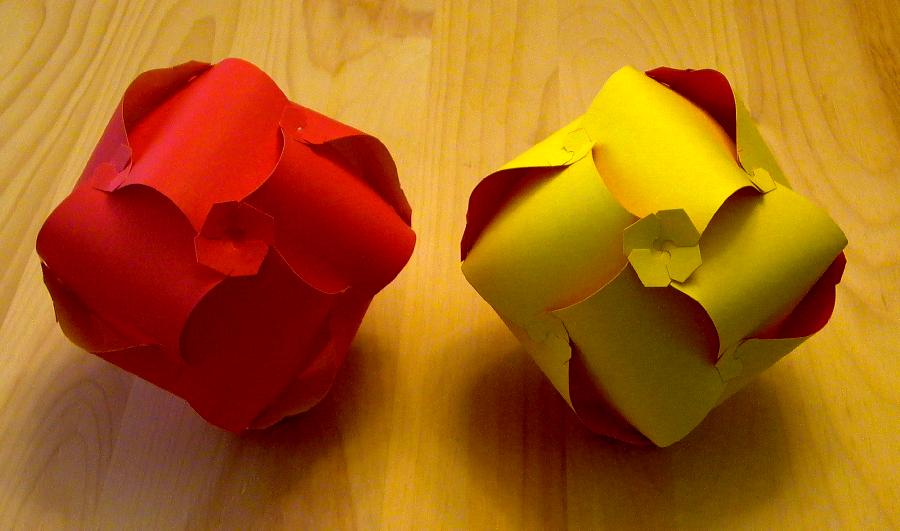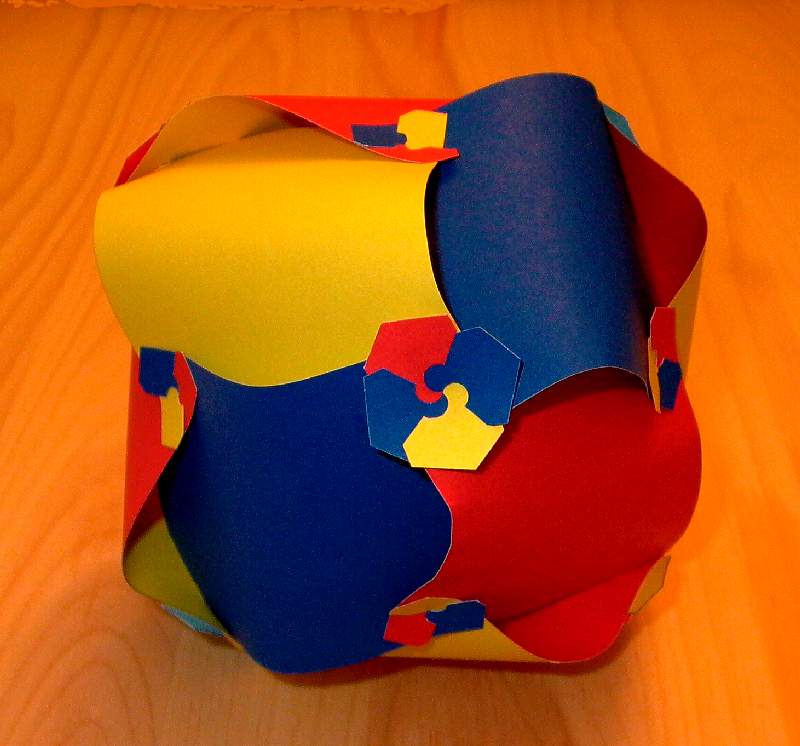The dodecahedron has 12 tiles and is not as spherical as the triacontahedron.
The same tiles and method can be used to build this rhombic dodecahedron.
Here are the differences:
| Properties |
Dodecahedron |
Triacontahedron |
| Diameter |
7 inches |
10 inches |
| # of tiles |
12 |
30 |
| # 3 tile vertices |
8 |
20 |
| # 4 tile vertices |
6 |
0 |
| # 5 tile vertices |
0 |
12 |
| # or rows North to South |
3 |
5 |
| First row: North Pole |
4 tiles vertical |
5 tiles vertical |
| Second row |
0 |
5 tiles horizontal |
| Third row: Equator |
4 tiles horizontal |
10 tiles vertical |
| Fourth row |
0 |
5 tiles horizontal |
| Bottom row: South Pole |
4 tiles vertical |
5 tiles vertical |
With the front of the tile facing outside, the finished dodecahedron is red.
With the back of the tile facing outside, the finished dodecahedron is yellow.
Remember not to mix front and back in the same assembly.

For preparation of an individual tile from a sheet,
see discussions under
spherical tessellations.
Step #1
Take 2 tiles, keep the long diagonal vertical, hook together at the bottom.
Note the tile on left is on top of the stack.

Put 4 tiles together like a deck of card.
All the tiles are hooked together at the bottom.
The left hand tile is on top and the right hand tile is at bottom of the stack.

Step #2
Bend the long edge of the tile on the left and hook under the short edge of
next tile to the right. Repeat this for all 4 tiles.
Step #3
The next row out from this rosette is the equator with 4 tiles.
The long diagonal is perpendicular to the tile in the North Pole.
The sharp corner connects to sharp corners in groups of 4.
The fat corner connects to fat corners in groups of 3.
The only thing left is the South Pole, which is same as the rosette at the North Pole.

This assembly looks good using 3 color tiles, as an example: red, yellow and blue.
The assembly method is the same as above, but the color cannot be used to
identify front and back of the tile, so it is a bit confusing.
The front and back of the tile are identified by the silhouette (boundary).
In the photo below, the equator (row #3) is blue.
The two poles are combined red and yellow.

Here is a view of the inside with 8 tiles assembled.

The finished rhombic dodecahedron with 3 color tiles.

Discussion of the tile for this construction
Return to Spherical Tessellations
Rhombic
polyhedron kit
William and Galen at
Oasis show August 2004
Order the kit with email
Last update:7/30/2004 Copyright 2004 by William Chow






